
The Malayo-Polynesian languages are a subgroup of the Austronesian languages, with approximately 385.5 million speakers. The Malayo-Polynesian languages are spoken by the Austronesian peoples outside of Taiwan, of the island nations of Southeast Asia and the Pacific Ocean, with a smaller number in continental Asia in the areas near the Malay peninsula. Cambodia, Vietnam and the Chinese island Hainan serve as the northwest geographic outlier. Malagasy, spoken in the island of Madagascar off the eastern coast of Africa in the Indian Ocean, is the furthest western outlier. The languages spoken south-westward from central Micronesia until Easter Island are sometimes referred to as the Polynesian languages.

Malay is an Austronesian language officially spoken in Brunei, Indonesia, Malaysia and Singapore, and unofficially spoken in East Timor and parts of Thailand. A language of the Malays, it is spoken by 290 million people across the Strait of Malacca, including the coasts of the Malay Peninsula of Malaysia and the eastern coast of Sumatra in Indonesia and has been established as a native language of part of western coastal Sarawak and West Kalimantan in Borneo. It is also used as a trading language in the southern Philippines, including the southern parts of the Zamboanga Peninsula, the Sulu Archipelago and the southern predominantly Muslim-inhabited municipalities of Bataraza and Balabac in Palawan.

Minangkabau is an Austronesian language spoken by the Minangkabau of West Sumatra, the western part of Riau, South Aceh Regency, the northern part of Bengkulu and Jambi, also in several cities throughout Indonesia by migrated Minangkabau. The language is also a lingua franca along the western coastal region of the province of North Sumatra, and is even used in parts of Aceh, where the language is called Aneuk Jamee.

South Sumatra is a province of Indonesia. It is located on the southeast of the island of Sumatra, The province spans 91,592.43 km2 (35,364 sq mi) and an estimated population of 8,497,196. The capital of the province is Palembang. The province borders the provinces of Jambi to the north, Bengkulu to the west and Lampung to the south. The Bangka Strait in the east separates South Sumatra and the island of Bangka, which is part of the Bangka Belitung Islands province. This province is rich in natural resources, such as petroleum, natural gas and coal. The province is inhabited by many different ethnic groups, with the Malays the largest ethnic group. Most speak Palembang Malay, which is mutually unintelligible to both Indonesian and Standard Malay. Other ethnic groups include the Javanese, Sundanese, Minangkabau and Chinese. Most are concentrated in urban areas and are largely immigrants from other parts of Indonesia.

Bengkulu is a province of Indonesia. It is located on the southwest coast of Sumatra. It was formed on 18 November 1968 by separating out the former Bengkulu Residency area from the province of South Sumatra under Law No. 9 of 1967 and was finalised by Government Regulation No. 20 of 1968. Spread over 19,813 km2, it is bordered by the provinces of West Sumatra to the north, Jambi to the northeast, Lampung to the southeast, and South Sumatra to the east, and by the Indian Ocean to the northwest, south, southwest, and west.
The Rejang script or Kaganga script, sometimes spelt Redjang and locally known as Surat Ulu, is an abugida of the Brahmic family, and is related to other scripts of the region, like Batak, Lontara, and others. Rejang is a member of the closely related group of Surat Ulu scripts that include the script variants of Bengkulu, Lembak, Lintang, Lebong, and Serawai. Other scripts that are closely related, and sometimes included in the Surat Ulu group, are Kerinci and Lampung. The script was in use prior to the introduction of Islam to the Rejang area; the earliest attested document appears to date from the mid-18th century CE. The Rejang script is sometimes also known as the KaGaNga script following the first three letters of the alphabet. The term KaGaNga was never used by the users of the script community, but it was coined by the British anthropologist Mervyn A. Jaspan (1926–1975) in his book Folk literature of South Sumatra. Redjang Ka-Ga-Nga texts. Canberra, The Australian National University 1964.

The Malayic languages are a branch of the Malayo-Polynesian subgroup of the Austronesian language family. The most prominent member is Standard Malay, which is the national language of Brunei, Singapore and Malaysia; it further serves as basis for Indonesian, the national language of Indonesia. The Malayic branch also includes the local languages spoken by ethnic Malays, further several languages spoken by various other ethnic groups of Sumatra and Borneo. The most probable candidate for the urheimat of the Malayic languages is western Borneo.

More than 700 living languages are spoken in Indonesia. These figures indicate that Indonesia has about 10% of the world’s languages, establishing its reputation as the second most linguistically diverse nation in the world after Papua New Guinea. Most languages belong to the Austronesian language family, while there are over 270 Papuan languages spoken in eastern Indonesia.
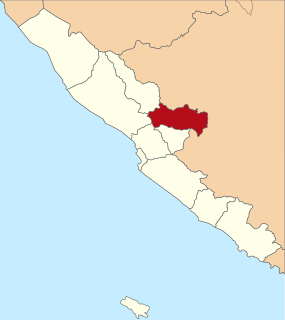
Rejang Lebong is a regency of Bengkulu Province, Indonesia, on the island of Sumatra. It covers 1,475.99 km² and had a population of 246,787 at the 2010 Census, but the latest official estimate is 263,010. The administrative centre of the Rejang Lebong Regency is the town of Curup.
Bengkulu is a Malayic language spoken on the Indonesian island of Sumatra, around the city of Bengkulu. It is more closely related to other Malay variants in Sumatra such as Col, Jambi Malay and Palembang Malay as well Minangkabau spoken in neighbouring West Sumatra than to the Rejang language, which is also spoken in the province.

Rencong is any native writing system found in central and south Sumatra, including Kerinci, Bengkulu, Palembang and Lampung. These scripts lasted until the 18th century, when the Dutch colonized Indonesia. These scripts were used to write manuscripts in native languages and in Malay, such as the Tanjung Tanah Code of Law. The Malay writing was gradually replaced by the Jawi script, a localized version of the Arabic script.

Karo, referred to in Indonesia as Bahasa Karo, is an Austronesian language that is spoken by the Karo people of Indonesia. It is used by around 600,000 people in North Sumatra. It is mainly spoken in Karo Regency, southern parts of Deli Serdang Regency and northern parts of Dairi Regency, North Sumatra, Indonesia. It was historically written using the Batak alphabet which is descended from the Brahmi script of ancient India by way of the Pallava and Old Kawi scripts, but nowadays only a tiny number of Karo can write or understand the script, and instead the Latin script is used.
The Simeulue language is spoken by the Devayan people of Simeulue off the western coast of Sumatra, Indonesia.
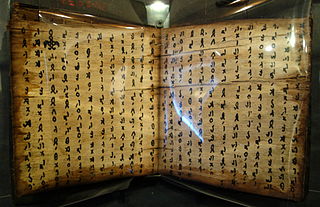
Mandailing or Batak Mandailing is an Austronesian language spoken in Indonesia, the northern island of Sumatra. It is spoken mainly in Mandailing Natal Regency, North Padang Lawas Regency, Padang Lawas Regency, and eastern parts of Labuhan Batu Regency, North Labuhan Batu Regency, South Labuhan Batu Regency and northwestern parts of Riau Province. It is written using the Latin script but historically used Batak script.

The Lampungese people, also commonly referred to as Ulun Lampung, are an ethnic group indigenous to Lampung province and parts of South Sumatra province of the southern and central region that occupy areas such as Martapura, Muaradua at upstream of Komering River, Kayu Agung, Tanjung Raja at downstream of Komering River, Merpas on the southern side of Bengkulu province, as well as Cikoneng in the southwest coast of Banten province, Indonesia. They speak the Lampung language, a Lampungic language estimated to have 1.5 million speakers.
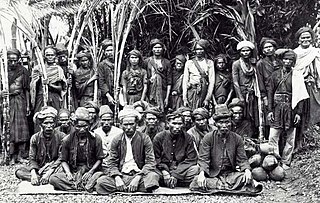
The Alas people are an ethnic group that inhabits Southeast Aceh Regency, Aceh, Indonesia. They speak the Alas language, which is related to the Batak languages.

The Bahau are an ethnic group in West Kutai Regency (9.3%), East Kalimantan, Indonesia.
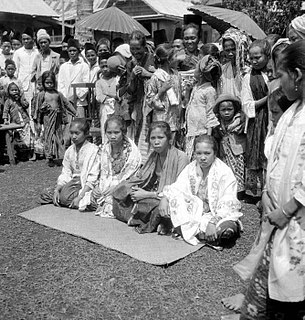
Rejang people are an Austronesian ethnolinguistic group, native to the some parts of Bengkulu Province and South Sumatera Province in the southwestern part of Sumatera Island, Indonesia. They occupied some area in an cool mountain slopes of the Barisan mountain range in both sides of Bengkulu and South Sumatra. With approximately more than 1,3 million people, they form the largest ethnic group in Bengkulu Province. Rejang people predominantly live as a majority in 5 out 10 regencies and city of Bengkulu Province, while the rest of them who lives in South Sumatera resides at 7 villages in the district called as Bermani Ulu Rawas. The Rejangs are predominantly an Islam adherent group with small numbers following a religion other than Islam. According to research, Rejang people are the descendants of the Bukar-Sadong people who migrated from Northern Borneo (Sarawak).
Rejang is an Austronesian language predominantly spoken by the Rejang people in southwestern parts of Sumatra (Bengkulu), Indonesia. There are five dialects, spread from mountainous region to the coastal region of Bengkulu, including the Musi (Musai) dialect, the Lebong dialect, the Kebanagung dialect, the Rawas (Awes) dialect, and the Pesisir dialect.
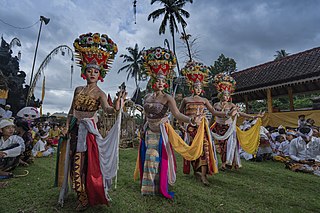
Rejang dance is a sacred Balinese dance, a sacrificial dance in which the girls offer themselves to the gods. It is usually held at the Hindu temple's of Klungkung Regency and Karangasem Regency in Bali, Indonesia. “Rejang” means “offering”, a dance to greet the gods that come down to the Earth. This dance is part of the sacred offering ceremonies, which all happen around about the same time on Bali’s ceremonial calendar.















